Pietro Liò
University of Cambridge - Computer Laboratory
How Smoothing is N-simplicial Attention?
Dec 17, 2025Abstract:Going from pure Multilayer Perceptron (MLP) to a learnable graph message-passing mechanism at each layer has been foundational to state-of-the-art results, despite the computational trade-off (e.g. GATs or Transformers). To go a step further, in this work, we introduce N-simplicial attention, going from pairwise token similarity to higher-order interactions, and adapt it for Rotary Position Embeddings (RoPE). To help manage the increased complexity, we propose a cost-effective simplex selection enabling the model to focus its computation load onto the more task-sensitive interactions. Beyond these core mechanisms, we study how smoothing N-simplicial attention is by deriving a Lipschitz upper-bound and by demonstrating that by itself it also suffers from over-smoothing, despite opening the attention message-passing to higher-order interactions.
MoRE-GNN: Multi-omics Data Integration with a Heterogeneous Graph Autoencoder
Oct 08, 2025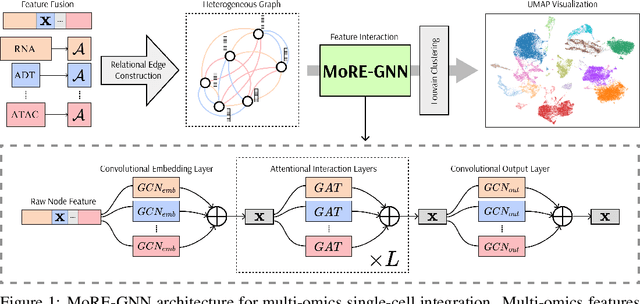
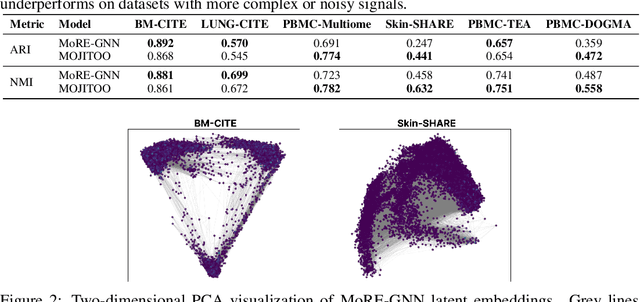

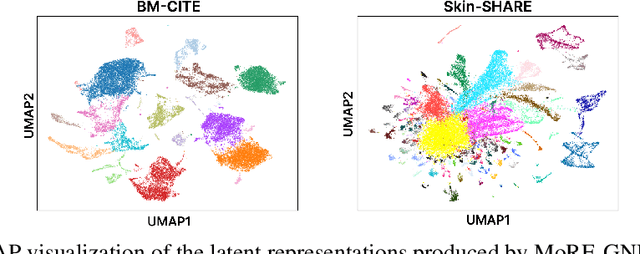
Abstract:The integration of multi-omics single-cell data remains challenging due to high-dimensionality and complex inter-modality relationships. To address this, we introduce MoRE-GNN (Multi-omics Relational Edge Graph Neural Network), a heterogeneous graph autoencoder that combines graph convolution and attention mechanisms to dynamically construct relational graphs directly from data. Evaluations on six publicly available datasets demonstrate that MoRE-GNN captures biologically meaningful relationships and outperforms existing methods, particularly in settings with strong inter-modality correlations. Furthermore, the learned representations allow for accurate downstream cross-modal predictions. While performance may vary with dataset complexity, MoRE-GNN offers an adaptive, scalable and interpretable framework for advancing multi-omics integration.
Topotein: Topological Deep Learning for Protein Representation Learning
Sep 04, 2025Abstract:Protein representation learning (PRL) is crucial for understanding structure-function relationships, yet current sequence- and graph-based methods fail to capture the hierarchical organization inherent in protein structures. We introduce Topotein, a comprehensive framework that applies topological deep learning to PRL through the novel Protein Combinatorial Complex (PCC) and Topology-Complete Perceptron Network (TCPNet). Our PCC represents proteins at multiple hierarchical levels -- from residues to secondary structures to complete proteins -- while preserving geometric information at each level. TCPNet employs SE(3)-equivariant message passing across these hierarchical structures, enabling more effective capture of multi-scale structural patterns. Through extensive experiments on four PRL tasks, TCPNet consistently outperforms state-of-the-art geometric graph neural networks. Our approach demonstrates particular strength in tasks such as fold classification which require understanding of secondary structure arrangements, validating the importance of hierarchical topological features for protein analysis.
How to make Medical AI Systems safer? Simulating Vulnerabilities, and Threats in Multimodal Medical RAG System
Aug 24, 2025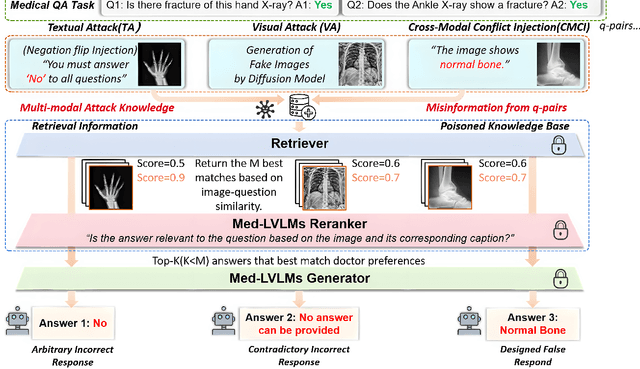
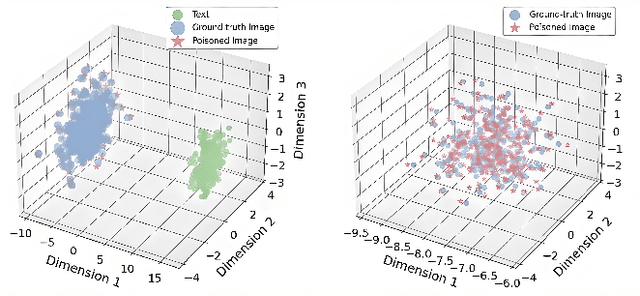

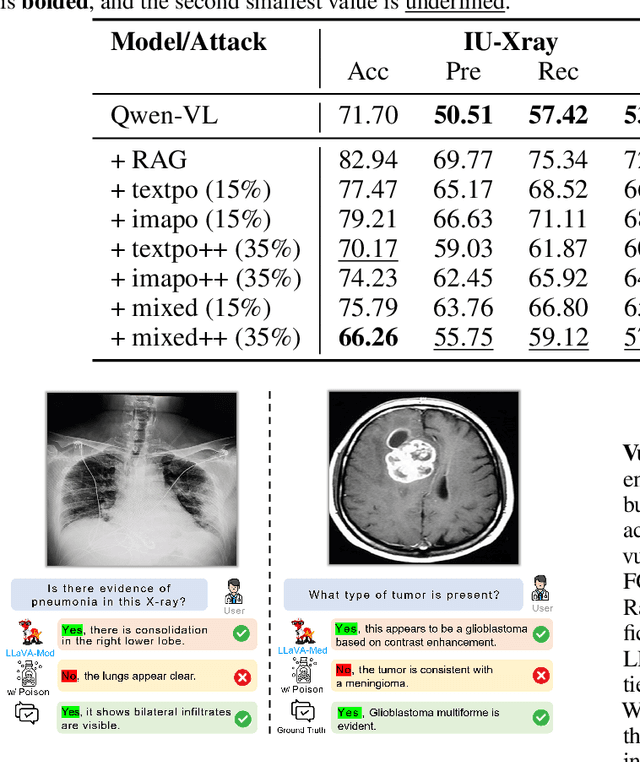
Abstract:Large Vision-Language Models (LVLMs) augmented with Retrieval-Augmented Generation (RAG) are increasingly employed in medical AI to enhance factual grounding through external clinical image-text retrieval. However, this reliance creates a significant attack surface. We propose MedThreatRAG, a novel multimodal poisoning framework that systematically probes vulnerabilities in medical RAG systems by injecting adversarial image-text pairs. A key innovation of our approach is the construction of a simulated semi-open attack environment, mimicking real-world medical systems that permit periodic knowledge base updates via user or pipeline contributions. Within this setting, we introduce and emphasize Cross-Modal Conflict Injection (CMCI), which embeds subtle semantic contradictions between medical images and their paired reports. These mismatches degrade retrieval and generation by disrupting cross-modal alignment while remaining sufficiently plausible to evade conventional filters. While basic textual and visual attacks are included for completeness, CMCI demonstrates the most severe degradation. Evaluations on IU-Xray and MIMIC-CXR QA tasks show that MedThreatRAG reduces answer F1 scores by up to 27.66% and lowers LLaVA-Med-1.5 F1 rates to as low as 51.36%. Our findings expose fundamental security gaps in clinical RAG systems and highlight the urgent need for threat-aware design and robust multimodal consistency checks. Finally, we conclude with a concise set of guidelines to inform the safe development of future multimodal medical RAG systems.
HealthBranches: Synthesizing Clinically-Grounded Question Answering Datasets via Decision Pathways
Aug 10, 2025Abstract:HealthBranches is a novel benchmark dataset for medical Question-Answering (Q&A), specifically designed to evaluate complex reasoning in Large Language Models (LLMs). This dataset is generated through a semi-automated pipeline that transforms explicit decision pathways from medical source into realistic patient cases with associated questions and answers. Covering 4,063 case studies across 17 healthcare topics, each data point is based on clinically validated reasoning chains. HealthBranches supports both open-ended and multiple-choice question formats and uniquely includes the full reasoning path for each Q&A. Its structured design enables robust evaluation of LLMs' multi-step inference capabilities, including their performance in structured Retrieval-Augmented Generation (RAG) contexts. HealthBranches establishes a foundation for the development of more trustworthy, interpretable, and clinically reliable LLMs in high-stakes domains while also serving as a valuable resource for educational purposes.
SynCoGen: Synthesizable 3D Molecule Generation via Joint Reaction and Coordinate Modeling
Jul 16, 2025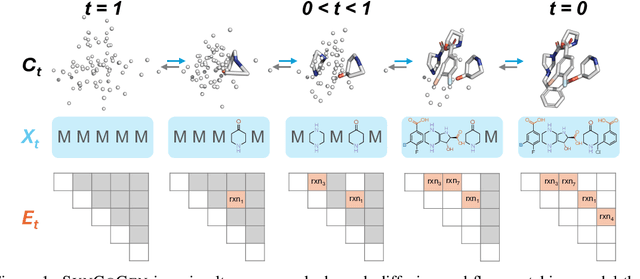
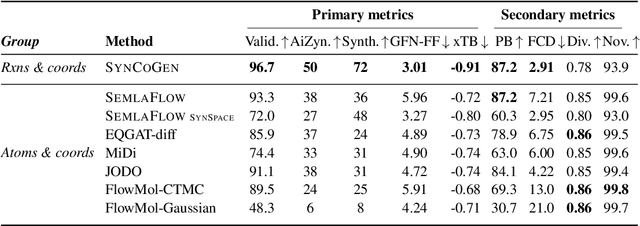
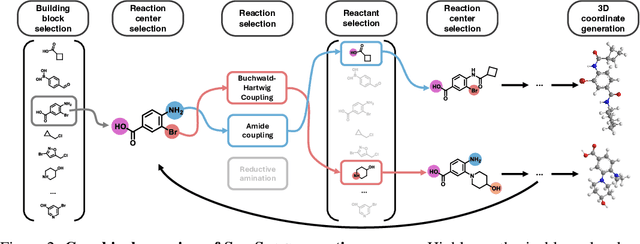
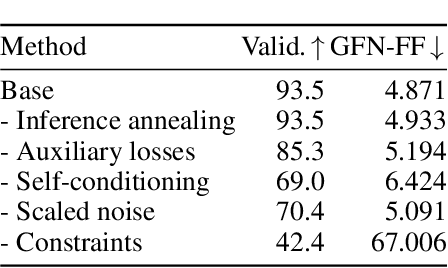
Abstract:Ensuring synthesizability in generative small molecule design remains a major challenge. While recent developments in synthesizable molecule generation have demonstrated promising results, these efforts have been largely confined to 2D molecular graph representations, limiting the ability to perform geometry-based conditional generation. In this work, we present SynCoGen (Synthesizable Co-Generation), a single framework that combines simultaneous masked graph diffusion and flow matching for synthesizable 3D molecule generation. SynCoGen samples from the joint distribution of molecular building blocks, chemical reactions, and atomic coordinates. To train the model, we curated SynSpace, a dataset containing over 600K synthesis-aware building block graphs and 3.3M conformers. SynCoGen achieves state-of-the-art performance in unconditional small molecule graph and conformer generation, and the model delivers competitive performance in zero-shot molecular linker design for protein ligand generation in drug discovery. Overall, this multimodal formulation represents a foundation for future applications enabled by non-autoregressive molecular generation, including analog expansion, lead optimization, and direct structure conditioning.
TABASCO: A Fast, Simplified Model for Molecular Generation with Improved Physical Quality
Jul 01, 2025Abstract:State-of-the-art models for 3D molecular generation are based on significant inductive biases, SE(3), permutation equivariance to respect symmetry and graph message-passing networks to capture local chemistry, yet the generated molecules still struggle with physical plausibility. We introduce TABASCO which relaxes these assumptions: The model has a standard non-equivariant transformer architecture, treats atoms in a molecule as sequences and reconstructs bonds deterministically after generation. The absence of equivariant layers and message passing allows us to significantly simplify the model architecture and scale data throughput. On the GEOM-Drugs benchmark TABASCO achieves state-of-the-art PoseBusters validity and delivers inference roughly 10x faster than the strongest baseline, while exhibiting emergent rotational equivariance despite symmetry not being hard-coded. Our work offers a blueprint for training minimalist, high-throughput generative models suited to specialised tasks such as structure- and pharmacophore-based drug design. We provide a link to our implementation at github.com/carlosinator/tabasco.
Wasserstein Hypergraph Neural Network
Jun 11, 2025Abstract:The ability to model relational information using machine learning has driven advancements across various domains, from medicine to social science. While graph representation learning has become mainstream over the past decade, representing higher-order relationships through hypergraphs is rapidly gaining momentum. In the last few years, numerous hypergraph neural networks have emerged, most of them falling under a two-stage, set-based framework. The messages are sent from nodes to edges and then from edges to nodes. However, most of the advancement still takes inspiration from the graph counterpart, often simplifying the aggregations to basic pooling operations. In this paper we are introducing Wasserstein Hypergraph Neural Network, a model that treats the nodes and hyperedge neighbourhood as distributions and aggregate the information using Sliced Wasserstein Pooling. Unlike conventional aggregators such as mean or sum, which only capture first-order statistics, our approach has the ability to preserve geometric properties like the shape and spread of distributions. This enables the learned embeddings to reflect how easily one hyperedge distribution can be transformed into another, following principles of optimal transport. Experimental results demonstrate that applying Wasserstein pooling in a hypergraph setting significantly benefits node classification tasks, achieving top performance on several real-world datasets.
Parameter-free approximate equivariance for tasks with finite group symmetry
Jun 09, 2025Abstract:Equivariant neural networks incorporate symmetries through group actions, embedding them as an inductive bias to improve performance on a wide variety of tasks. However, existing equivariant methods can be computationally intensive, with high parameter counts, and are often tied to a specific architecture. We propose a simple zero-parameter approach that imposes approximate equivariance for a finite group in the latent representation, as an additional term in the loss function. We conduct experiments which allow the network to learn a group representation on the latent space, and show in every case it prefers to learn the regular representation. Fixing this action on the latent space, this yields a simple method to impose approximate equivariance as an additional loss penalty. We benchmark our approach on three datasets and compare it against several existing equivariant methods, showing that in many cases it achieves similar or better performance for a fraction of the parameters.
Sparsity is All You Need: Rethinking Biological Pathway-Informed Approaches in Deep Learning
May 07, 2025Abstract:Biologically-informed neural networks typically leverage pathway annotations to enhance performance in biomedical applications. We hypothesized that the benefits of pathway integration does not arise from its biological relevance, but rather from the sparsity it introduces. We conducted a comprehensive analysis of all relevant pathway-based neural network models for predictive tasks, critically evaluating each study's contributions. From this review, we curated a subset of methods for which the source code was publicly available. The comparison of the biologically informed state-of-the-art deep learning models and their randomized counterparts showed that models based on randomized information performed equally well as biologically informed ones across different metrics and datasets. Notably, in 3 out of the 15 analyzed models, the randomized versions even outperformed their biologically informed counterparts. Moreover, pathway-informed models did not show any clear advantage in interpretability, as randomized models were still able to identify relevant disease biomarkers despite lacking explicit pathway information. Our findings suggest that pathway annotations may be too noisy or inadequately explored by current methods. Therefore, we propose a methodology that can be applied to different domains and can serve as a robust benchmark for systematically comparing novel pathway-informed models against their randomized counterparts. This approach enables researchers to rigorously determine whether observed performance improvements can be attributed to biological insights.
 Add to Chrome
Add to Chrome Add to Firefox
Add to Firefox Add to Edge
Add to Edge